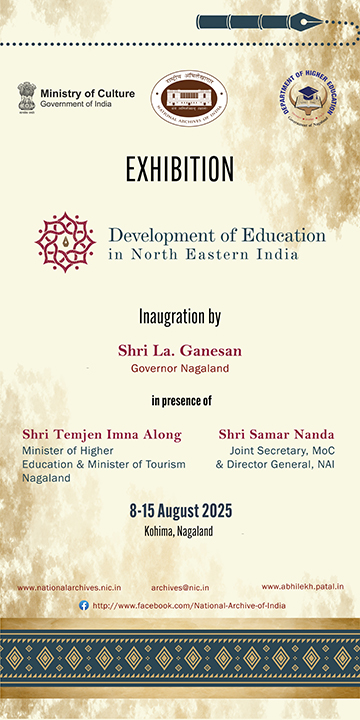National Archives of India "Development of Education in North Eastern India"

National Archives of India
Development of Education in North Eastern India
About the Exhibition
The North-Eastern region of India, comprising Arunachal Pradesh, Assam, Manipur, Meghalaya, Mizoram, Nagaland, and Tripura, has undergone a distinctive educational evolution deeply rooted in its diverse cultural fabric, tribal heritage, and linguistic plurality. This region's educational journey reflects a unique confluence of indigenous knowledge systems, missionary endeavors, colonial influences, and post-independence state policies. Together, these forces have shaped an educational landscape that mirrors the socio-political and cultural complexities of Northeast India.
Formal education in this region largely took root through missionary activities, particularly those led by American Baptist and other Christian missions during the 19th century. While these missions initially pursued proselytization, they soon recognized education as a transformative tool to engage with local communities. They translated their religious and secular texts into native languages, and introduced Western curricula. This marked the beginning of a significant shift from traditional oral knowledge systems towards structured educational frameworks.
The colonial period further entrenched formal education through British administrative reforms. Alongside missionary schools, government-run institutions promoted English-language instruction and Western academic subjects, intending to create intermediaries who could serve colonial administration needs while nurturing emerging regional elites. This era witnessed the establishment of foundational educational institutions, including prominent colleges and schools that set the stage for future educational expansion and modernization in the region.
Following India's independence, the educational landscape in Northeast India expanded dramatically, fueled by national policies emphasizing universal access and regional development. The founding of key universities such as North Eastern Hill University and Nagaland University signaled a commitment to higher education tailored to the region’s needs. Government investments increased, and there was a concerted effort to integrate regional languages and cultural identities into the curricula, striving to balance the preservation of local heritage with national educational objectives.
This exhibition seeks to capture and present the multifaceted history of education in Northeast India through archival documents, and scholarly materials. It endeavors to illuminate the interplay between indigenous traditions, missionary legacies, colonial frameworks, and modern state policies that collectively shaped the region’s educational institutions. By tracing these developments chronologically and thematically, the exhibition offers visitors an opportunity to explore how education in Northeast India has evolved as both a reflection of and a response to broader socio-political dynamics.
The exhibition will be based on various documents, private papers, rare books from the National Archives of India, New Delhi, Department of Higher Education, Govt. of Nagaland, State Archives, Department of Art and Culture, Govt. of Nagaland and other government documents providing a historical context. It will also include visual displays, photographs, and multimedia presentations that capture the essence of the educational legacy of Northeast India







